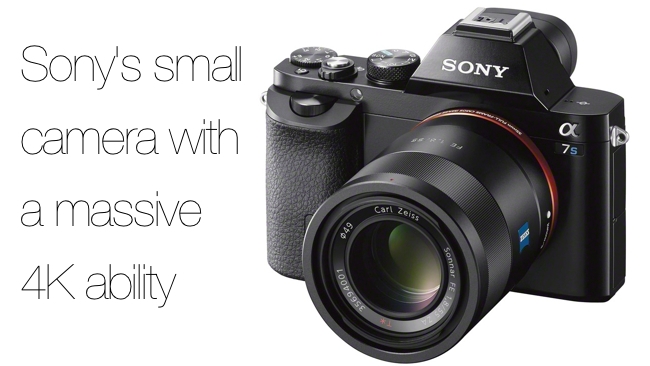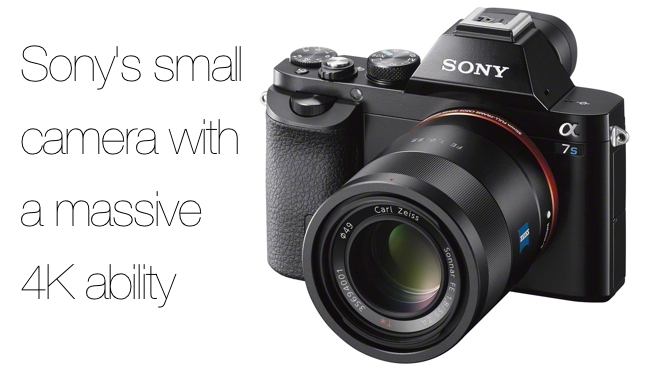
 Sony A7s
Sony A7s
Sony's new A7s is a well thought out 4K-capable camera. Sony briefed us, giving some more information
Sony's A7s, announced in a segment of Sony's main annual press conference on Sunday at NAB, is real, and we've had it in our hands at a special one-to one (actually one to three as there were two colleagues from a French publication there) briefing in a back-room at the Sony booth.
It's tempting to think that this very small interchangeable-lens camera that's capable of capturing in 4K is a knee-jerk reaction to Panasonic's much lauded GH4, but in my view that's just wrong. For a start, this is quite clearly a very carefully strategised product: it's not something that's been rushed out. In any case - Japanese companies never rush things out: they're too detail oriented for that.
It's more likely that this is a response to the predicted demand for a small, affordable, 4K -capable camera.
Obvious
It was obvious that the Japanese team of designers and marketers present at the briefing were immensely proud of this new camera, which makes it even less likely that it was brought to market in a hurry. I suspect the opposite is the case.
The statistics surrounding the A7s are curious. In an age where we expect everything to get bigger, this device actually has fewer pixels than a typical digital still camera. 12.2 megapixels looks quite paltry compared to the 26 megapixels of some of Sony's own cameras. But there's a very good reason for that: the pixels are better pixels. It means that the pixels are bigger, and can collect more light. The difference is tangible: this camera has an insanely high sensitivity. With a maximum ISO sensitivity of 409,600 it can resolve detail in the dark where other cameras would just see dark.
How many pixels do you need?
Let's deal with this pixel thing. You can take a great picture with 8 megapixels. Only a few years back one of Canon's top cameras for sports photography had only 8 megapixels, and was used for magazine and newspaper photography. 4K video is 8 megapixels per frame, and it's widely acknowledged that you can use frame grabs from 4K cameras to make very decent still photos.
So how good is 12.2 megapixels? Easily good enough for almost everything. Canon's top still camera, the 1DX only has 18 megapixels, and that's only 50% more than the A7s. If you wanted to double the pixel resolution, you'd have to have 400% more pixels; not just 50%.
I've used a 12 Megapixel camera - the EOS 5D Mk 1. It took great pictures and the relatively low pixel count was never, ever a problem - even when I made A1 - sized prints
Feeling
How does the camera feel? Small but solid. It's quite clear that this is a camera that's built to last. The overall chunkiness is enhanced by the physical control knobs on the top edge. It feels every inch a quality product.
Still photos are stunning. Because of the high sensitivity, you can capture photos in very badly lit scenes. We saw several examples including one of a beautifully (naturally!) lit athlete vaulting over an obstacle. It was completely sharp, and the ability to shoot with such a fast shutter speed is a direct benefit of the high sensitivity - and, ultimately, the lower pixel count.
The video is very good too. We saw some examples of 4K video, although I'm not sure how they were obtained as the camera doesn't record 4K internally, and the only 4K external recorder, the newly announced Atomos Shogun, won't be available until later in the year.
But however they were obtained, the 4K pictures were stunning.
Sony sees the A7s as a product that crosses over between consumer and professional products. It will be available with an XLR add on do deal with professional audio recording.
We got some more information about the camera.
It's the smallest 35mm interchangeable-lens camera body. It's full-frame. The sensor has a 12 stop dynamic range.
Other features include S-Log 2, Picture profile, high frame rate (120 fps at 720p) and Record Trigger in HDMI feed (allows it to be started and stopped by an external HDMI recorder.)
The camera doesn't use Pixel Binning or Line Skipping to reduce the resolution from the full sensor to 4K, which will eliminate many of the problems normally seen with video-capable DSLRs and other still camera types.
Speaking of which, the only 4K-cable recorder with an HDMI input is the newly announced Atomos Shogun. Sony and Atomos worked together to make this work properly and well. (Note that the Atomos Shogun isn't going to ship until the end of Q3 2014 at the earliest. )
With an XLR add- and Timecode, this is clearly a camera that is aimed at least in part at professionals.
You can't record 4K internally to this camera, which makes it a fundamentally different product to the Panasonic GH4. But with the addition of an Atomos Shogun, you not only get a 7" viewfinder but the ability to record in pro-res, all the way up to 4K.
We've already been promised early review samples of the A7s and the Atomos Shogun, and we'll bring our hands-on trial as soon as we get them.
Tags: Technology


Comments